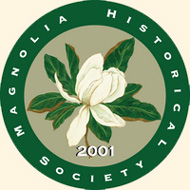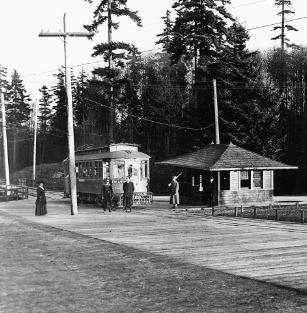By Monica Wooton
Co-President Magnolia Historical Society
(updated 2/14/2014)
A Magnolia Bike Path Map from 1900
A timeline of the boulevard (from the 1998 Vegetation Plan )
The complete 1998 Vegetation Plan
The Magnolia Boulevard, the street and the homes that reside along the exceptional strip of 12.1 acres of view property on Magnolia’s west edge have had a rich and long local history attached to them. In 1903, three years after it became part of the City’s 25-Mile Bike Path, the Olmsteds suggested it be one of the prominent boulevards in their City of Seattle Park Plan. The promenade has had lengthy negotiations between developers, residents and the city. Many twist and turns of local politics gave us the road we see today and the homes that stand beside it. The Olmsteds did not in the end design the Boulevard, that task was done by Samuel C. Lancaster, the engineer behind the Columbia River Gorge scenic drive. (See Snapshot in Time, 3/28/2012.)
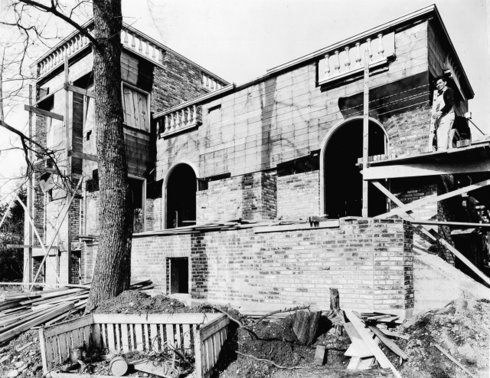
Dr. Cecil L.Tenny’s home under construction in the 1900 block of Magnolia
Boulevard West in the early 1930s.
Photo by Webster & Stevens. Courtesy of Julie Lent Sanders.
The view property has been a tussle between City and residents as to proper and appropriate maintenance of view corridors and especially care or removal of the Madrona which have long been an icon of the Boulevard. Street racing on the Boulevard in the 40s and 60s was serious business for the young males of Seattle. The (passion) “Pits” – an informal place to watch the “submarine races” and favorite make-out spot for teens has turned into the formal Magnolia Boulevard Viewpoints. Tour companies visit it on a regular basis to get a good view of Mt Rainier, West Seattle, Washington State Ferries, the islands across the sound, and the City skyline. The road remains unlit at night because residents did not want the glare disturbing evening and night views.
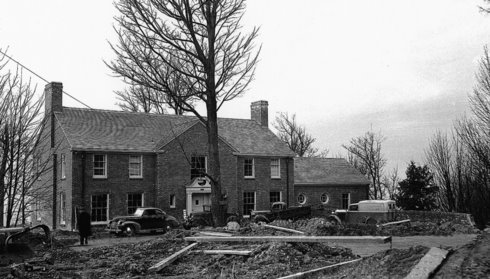
Home built by Mrs. Margaret P. Wilson on Magnolia Boulevard West between West Barrett Street and West Dravus Street. The house was constructed to resemble the family home in New York. Washington State Archives, Puget Sound Regional Branch, Bellevue. 1940.
In Magnolia: Making More Memories, Claudia Isquith laid out the history of the street and its houses:
“Magnolia Boulevard’s homes consist of an interesting array of architectural styles, sizes, and exterior finishes. There are houses featuring English Country, Tudor, Colonial, Spanish, Mediterranean, Dutch Colonial, Federal, and contemporary styles. They are built with brick, stucco, wood, and stone, and their look exhibits the varied tastes of the original owners. Very few of these houses were built prior to 1920. The late 1920s and 1930s saw a flurry of construction, and many of those homes were designed by prestigious architects for well known Seattle business people…”
“As early as 1903, the Olmsted Brothers proposed a boulevard…The boulevard referred to in the 1903 report was to be placed 125 to 130 feet above the low water mark and would then gradually descend 20 or 30 feet, winding around the area of land above and north of the Cove and forming the far end of Magnolia Bluff.
“Magnolia Boulevard was to be created through a condemnation ordinance, acquiring the land from property owners. In October 1909, prior to this ordinance, the Seattle Park Department offered James W. Clise $50,000 for a strip of land from Wolfe (Wolf) Creek ravine upland for a boulevard right of way. Clise turned down the offer and that was the beginning for Clise of years of dealing with the City and the Park Department over this land.”
And, from such beginnings the long and winding road we now know as Magnolia Boulevard came to be.
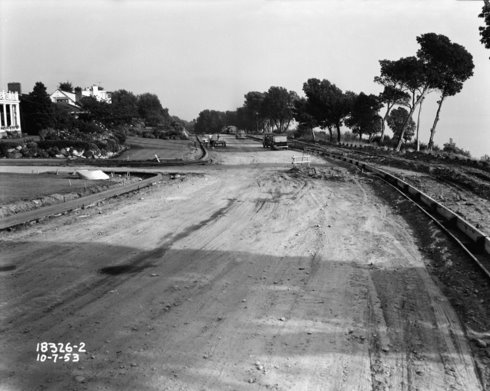
Road work widening Magnolia Boulevard West.
Seattle Municipal Archives, Engineering Department Photographic Negatives, #44547. October 7, 1953.
Now…
The Magnolia Historical Society will present: “The Not So Secret and Secret History of the Boulevard” at its upcoming annual meeting. The public is invited to a presentation with historic information and archival photos. Writer Claudia Isquith will discuss her research on the street and local historian Mimi Sheridan will talk about the architecture and history of the homes. Join us February 13th, Thursday evening, 7-9pm, at Magnolia Lutheran Church’s Fireside Room, for an interesting meeting. Bring your tales, pictures and insights as we discover and discuss what went on and continues today to make this great Boulevard.
Many long-standing houses are undergoing massive renovations and remodels. The once most recognized and iconic white California Spanish Style Stucco on the upper curve of the road has been refashioned into a large Modern Bungalow. Stories have been added to homes and views have been in contention in recent years.
Today Madronas are succumbing to blight due to viruses/fungus and the loss of forest around them and the groves of trees that once dotted that drive. And, after some neglect and long discussions and battles over view-rights and Madrona tree health, Magnolia Boulevard is being revived as a prominent and well-landscaped promenade with more grass, neatened up swaths of controlled weeds and brush with more park benches and view corridors.
The majestic Madrona trees are failing and how long they will be a part of the landscape is unknown; but, City Arborist Mark Mead says their days are most likely numbered. To long-time Magnolians the loss of the Madronas is heartbreaking; to others, it becomes an opportunity to maximize views and property values. (See, The Magnolia News: City, Community work to save Magnolia Blvd. Landscape, 12/3/2013.)
_
Sources: Seattle Parks and Recreation Website, The Magnolia News, “Street Racing Glory Days of Street racing on the Boulavard”, 10/4/2012; Magnolia: Making More Memories, “Magnolia Boulevard West”, Claudia Isquith, pp 33-43; Magnolia Vegetation Management Plan, May 1998, Janis Snoey, Project Manager, Interview with Seattle City Arborist Mark Mead, Fall 2013.

